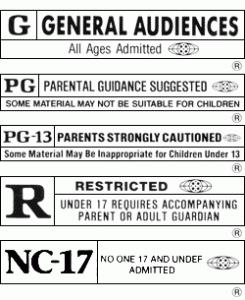
About the Clyde
So how do movies get their ratings?
 You may be surprised to learn that the ratings assigned by the Motion Picture Association of America (MPAA) are not laws—you can’t call the police if a theater unintentionally lets your 16-year-old into an R-rated movie. In fact the whole rating process is voluntary for filmmakers, and is sometimes skipped by the makers of smaller or foreign films.
You may be surprised to learn that the ratings assigned by the Motion Picture Association of America (MPAA) are not laws—you can’t call the police if a theater unintentionally lets your 16-year-old into an R-rated movie. In fact the whole rating process is voluntary for filmmakers, and is sometimes skipped by the makers of smaller or foreign films.
The MPAA first suggested this self-regulatory process as an industry-friendly alternative to heavy-handed government restrictions that varied from state to state and sometimes county to county. The MPAA is very clear that the only purpose of the MPAA rating system is to help parents decide whether or not to take a child to see a particular movie. At its website (www.mpaa.org/movieratings/about/index.htm) the MPAA says bluntly, “Ratings are meant for parents, no one else.”
We agree with the MPAA that parents bear the ultimate responsibility to protect their children from material that is not age-appropriate, and we urge parents to read about movies before they take their kids to them. While the MPAA board of 8-13 adults with parenting experience tries to represent mainstream American values, they may not represent your values in regard to yourparticular child.
What do the ratings mean?
A film’s rating may be influenced as much by marketing decisions as by content. A G rating is considered the kiss of death for preteens, so a filmmaker may add a minor curse word to get a more acceptable PG. On the other hand, some filmmakers will work with the MPAA ratings panel at snipping a second here and a second there to get a more commercial PG-13 rating rather than an R. That same last-minute editing may move a film from the hard-to-advertise NC-17 category to an R. Director Robert Altman famously fought for an R rating rather than a PG-13 for his 2001 filmGosford Park because he wanted to keep noisy teenaged boys out of his movie.
Here’s what the ratings mean to parents:
G means a film is suitable for general audiences. Anyone can see a G-rated film. A G rating does not mean that a film is relentlessly sunny, however. Many of us were traumatized at an early age by the death of Bambi’s mother or the meaness of the evil stepmothers in G-rated Disney films. But film incidents like these do become wonderful “teachable moments” for family discussions of death, evil, and less admirable character traits like jealousy and insecurity. A G rating does not necessarily mean a film is for children, it just means that there is nothing in the film that would offend them.
PG means that the film requires some parental guidance as to whether it is appropriate for the ages and development stages of individual kids. A PG film might have some scary moments that would be too much for a 3-year-old but fine for a first-grader, for instance a realistic character may be in peril. There may be all sorts of violence actually, as in the Star Wars movies, but not much gore.A PG-rated film may be a sweet movie that is essentially aimed at adults, or a very long movie. It might have subtitles, a challenge for younger or slower readers. It might have some use of the “s word.”
PG-13 means that the MPAA board thinks that the film is okay for kids over 13, but that parents are strongly urged to make their own decisions as to whether the movie will be appropriate for younger children. Oral or written permissions are not required by theaters for PG-13 films, as this is a “guidance only” situation. A movie may be rated PG-13 for:
- sexual innuendo
- premarital sex
- nudity that “is not sexually oriented”
- violence
- bad language (including the “f word” though using it as a verb or more than once gets you an R)
- adult themes such as domestic abuse or extramarital sex
- drug use content
- bathroom humor, or
- heavy suspense.
Some of these may be hot buttons for you, and some may be trivial. PG-13 films put a heavier responsibility on parents. That’s why we give you as much information as we can in our taped phone messages, in our on-line calendar, and through the on-line links for movie-going parents provided here.
R rating means that no one under 17 will be admitted without parental permission. Once again, this is not a law, but a self-policing strategy by the movie industry (which nonetheless intentionally markets some R-rated movies to younger kids). An R movie is intended for adults, and for these purposes 17-year-olds are considered to be adults. Movies may be rated R for a wide variety of reasons, from mild to really adult. It pays to check for the reasons for the rating.
R movies run the gamut. An R-rated movie may only use the “f word” once or twice, or it may contain so much cursing it makes your ears ache. A movie may be R because it shows some loving (nonexplicit) sexual behavior between two married people, unmarried people, or a gay couple, or because it shows a grueling rape or some kinkier stuff. It may be R for one brief but shocking scene of violence that is essential to the story or because of two hours of gratuitous gore. There have been some films that seemed to be rated R only because they required an adult attention span. Once again we urge parents to educate themselves about the movies their kids want to see. If you’re not sure about a movie, you may decide to see it together so that you can talk about any problematic issues brought up by the movie.
NC-17 means that no one aged 17 or under will be admitted to the movie with or without a parent or guardian. This rating was created to indicate a movie made for and intended for adults but not meant for porn palaces. An NC-17 movie is judged too strong for people who aren’t old enough to vote or serve in the military. It may contain more violence, sex, drug abuse, or “aberrational behavior” than an R-rated movie. We have shown only one or two NC-17 movies since the rating was invented, one of them an Oscar nominee.








